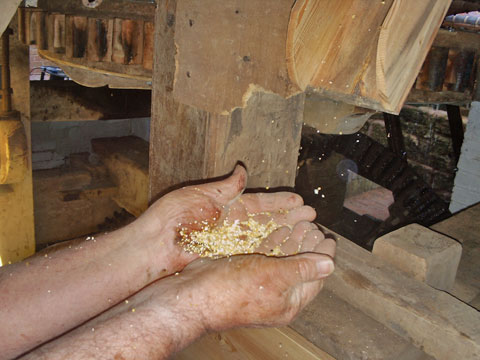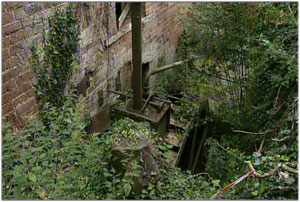Best viewed in landscape
Flour - Watermill Blog
5th March 2009

We ground maize into flour today. After a day when most of the team pointed up brickwork with lime mortar or looked for lost keys we finally tried out the millstones on some real grain.
John D, Bob, Max and Dave all shared a mixer full of lime mortar and got quite a lot of the stable brickwork re-pointed. Jonathan escaped pointing tedium by shaping and fixing metal caps on some of the fence posts.
John N added two more steps to the flight leading up from the stream, sinking sections of timber sleeper into the soil. Apart from digging out the sockets for the steps he also did more than a little of the sawing to cut the sections from a railway sleeper.
Colin and Richard modified the main drive belt for the lineshaft, making it a couple of inches longer. The last time we fitted it it seemed a bit taut so we were very surprised when the lengthened belt was even harder to stretch over the pulleys. Once someone noticed that the belt was looped over the hayloft handrail as well as both pulleys it became much easier to fit.
Still smarting from the embarrassment of that mistake they moved into the mill and improved the control for the grain shoe. This is basically a length of string that lifts and lowers the end of the grain shoe, controlling the rate at which grain is fed into the millstones. The other end of the string is fastened to a peg on the floor below so that the miller can control it from there.
We really wanted to try it out so Colin and Richard went in search of a bag of grain to mill. Once they had found Colin's car keys, that is. It was a bad day for keys as Mrs Max had turned up on site in the morning wanting to know why Max had both sets of house keys. Colin's keys turned up in his discarded jacket pocket and a visit to Firkin's animal feed emporium in Great Witley furnished us with a large bag of whole maize.
We wanted something quite big to put through the stones as we were not too confident about the alignment of the stones and maize seemed ideal.
Maize was loaded into the hopper and the waterwheel was powered up. We lowered the grain shoe so that corn was falling into the centre of the stones. The tentering screw was turned to lower the runner stone towards the bedstone and very soon coarse cornflour was dropping down the chute.
The top picture shows John N's hands catching those first grindings. A small adjustment to the tentering screw made the output much finer, almost like commercial flour. The whole team stood round watching, it was quite a momentous moment after the work that has gone into the mill.

As far as we can determine, the last time the mill ground anything was about 1927 so the stones have been idle for at least 80 years.
The restoration was started in earnest in July 2006 so we have gone from derelict to working in two and a half years.
This picture shows the waterwheel and sluice box as they were when we first started. No wonder most MAC members didn't know that there was even a watermill on the site!
There is still plenty of work to be done, there is another pair of stones to bring back into use, for example. We need to protect some of the machinery from visitors and vice versa. There is a big lathe to re-build. The list goes on and on but today we ground some flour and went home happy.
Go to the next entry after this flour story
Go to the previous Watermill Blog entry
Learn how to Support Us
Return to our Home Page